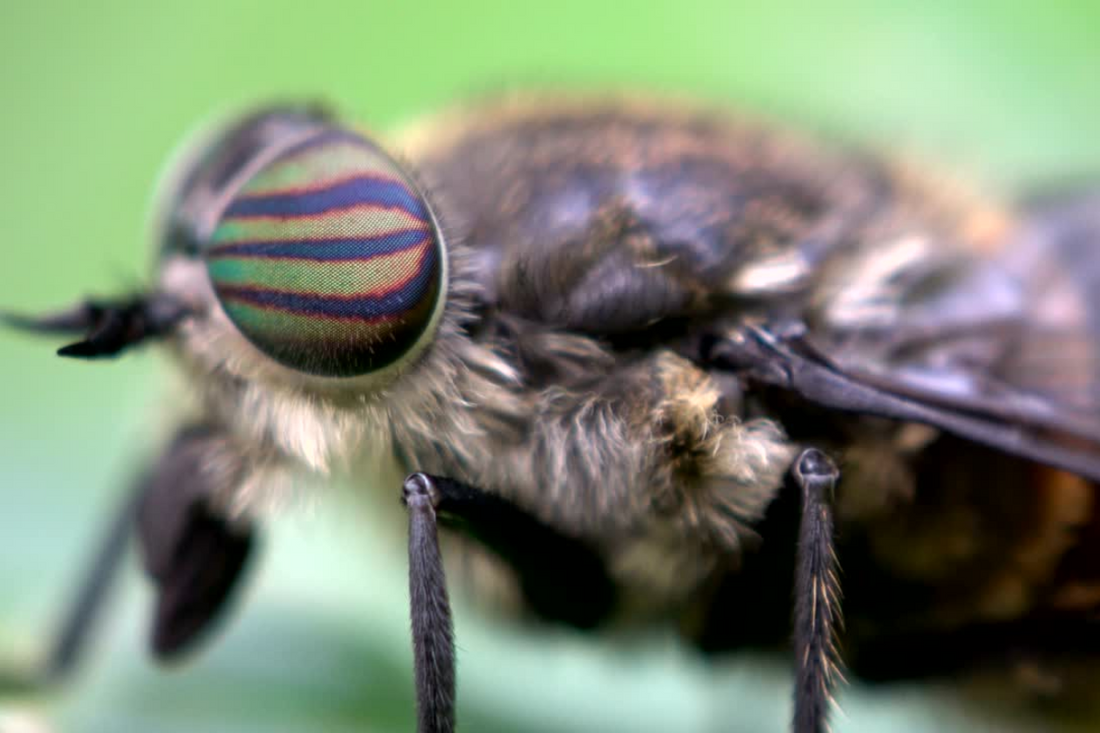
The Painful Truth About Horse Flies: Breeding, Biting, and How They Hunt
Share
If you’ve ever spent time around horses or just outdoors during summer, you’ve likely had a run-in with one of nature’s most persistent pests: the horse fly. Known for their painful bites and seemingly relentless pursuit of blood, these buzzing menaces can be more than just a nuisance. Let's find out more about them by breaking down the lifecycle, hunting tactics, and the specific consequences of a horse fly bite.
The Breeding Cycle of Horse Flies

Horse flies (family Tabanidae) have a complex and somewhat creepy reproductive cycle. Here’s how it goes:
Mating and Egg Laying: After mating, female horse flies lay their eggs in clusters, sometimes hundreds at a time, on vegetation near water sources like ponds, marshes, or slow-moving streams.
Larval Stage: Once hatched, the larvae drop into moist soil or water where they become fierce little predators themselves. They feed on tiny insects, worms, and organic material. This stage can last anywhere from a few months to over a year, depending on the species and environment.
Pupation and Emergence: When the larvae are ready, they pupate in drier soil. After about 1-3 weeks, adult horse flies emerge, ready to hunt and mate.
One fun (or horrifying) fact: it's only the females that bite. They need blood to develop their eggs. Males? They stick to nectar and pollen.
How The Horse Fly Hunts
Horse flies are visual hunters, especially drawn to:
- Dark colours (like black or dark brown)
- Shiny surfaces
- Movement
Once they lock onto a target—say, a sweaty horse on a hot summer day—they'll circle and dive-bomb persistently. Unlike mosquitoes that sneakily draw blood through a needle-like snout, horse flies cut the skin with scissor-like mouthparts and lap up the blood that flows out. That’s why their bites are so painful!
They’re also notoriously hard to swat. Their large eyes give them nearly 360-degree vision, and they’re fast. Their bite can also penetrate clothing and some fly rugs.
What Happens When a Horse Gets Bitten By A Horse Fly

A horse fly bite is no joke for your equine friend. Here’s what can happen:
- Pain and Discomfort: The initial bite hurts and may cause the horse to flinch, twitch, or bolt. You might notice tail swishing, stomping, or head tossing as they try to drive the fly away.
- Swelling & Inflammation: The bite site can become red, swollen, and warm. Some horses develop a localised allergic reaction.
- Infection Risk: Because horse flies cut the skin open, there’s a higher risk of infection, especially if the bite is scratched or left untreated.
- Disease Transmission: Horse flies are mechanical vectors, meaning they can transmit blood-borne diseases like equine infectious anaemia (EIA) simply by feeding on an infected animal and then biting another.
How to Protect Horses from Horse Flies
- Fly sprays: Use a repellent that contains the active ingredient Icaridin - a proven powerful broad-spectrum human-grade repellent that will repel midges, mosquitoes, flies, including horse flies; mites and ticks for 7+ hours.
- Fly sheets & masks: Zebra fly sheets confuse their sight and lightweight fly gear helps shield vulnerable areas.
- Stable management: Keep stalls clean and avoid standing water to limit breeding grounds.
- Fly traps: Especially around pastures and barns, these can help reduce the population.
- Fans: Fans can effectively deter flies in stables by creating a disruptive air current that makes it difficult for them to fly and navigate.
Why Repellent Is Your Horse’s Best Friend

Although Horse Flies hunt by sight, if they smell something unattractive, e.g., Icaridin or Oil of Lemon Eucalyptus, then their prey will become less appetising. So, while fly sheets, masks, and barn traps help, fly repellent spray is the fastest, most flexible, and effective defence against horse flies.
Here’s why:
- Creates an invisible barrier that repels flies before they land
- Protects exposed skin (legs, belly, ears—where flies love to bite)
- Convenient to apply before turnout, trail rides, or shows
- Deters other biting insects
Final Thoughts
Horse flies may be a part of the ecosystem, but that doesn’t mean we (or our horses) have to suffer through their bites. By understanding their lifecycle and how they hunt, we can better defend our animals and ourselves from their painful bites. Remember: prevention is key.
Top Tip: Spray Before They Bite
Horse flies are fast, strong, and stubborn—but repellent gives you control. Make it part of your daily grooming routine to keep your horse comfortable, calm, and focused.

1 comment
That is interesting, you never stop learning do you!